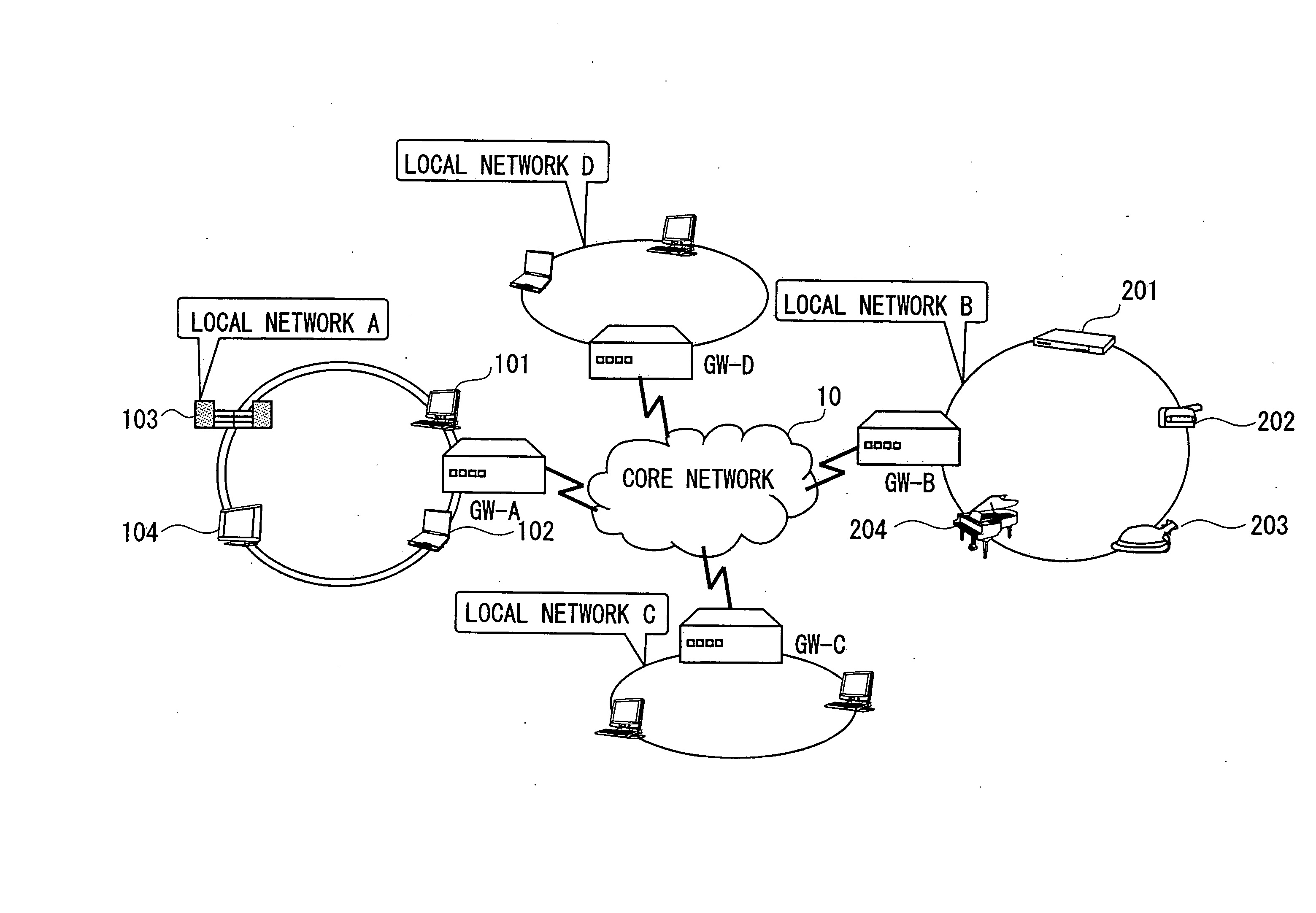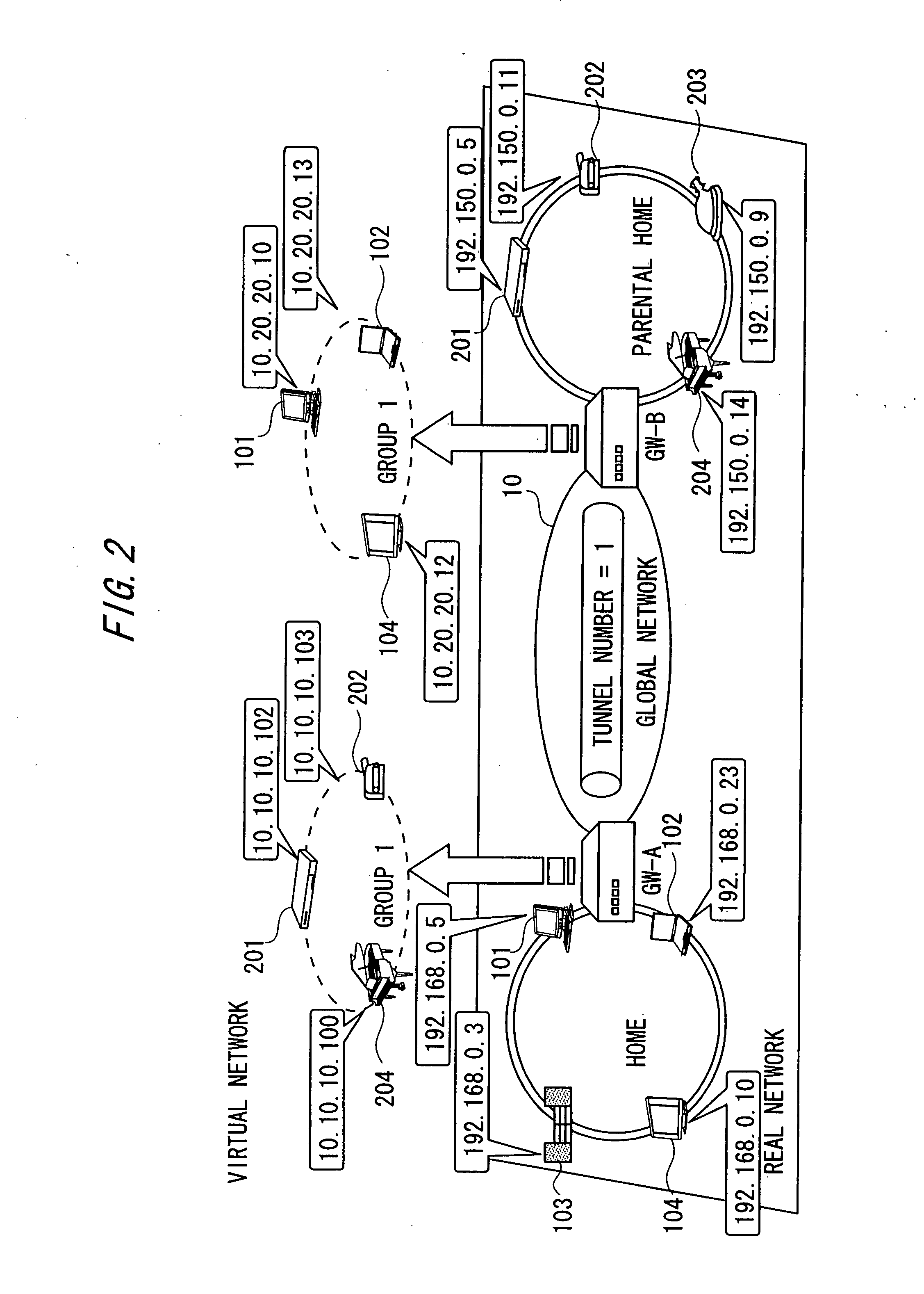Packet relay device
a relay device and relay technology, applied in data switching networks, multiplex communication, digital transmission, etc., can solve the problems of loss of multicast communications merit, heavy load on the routing process of each relay device, and management burden, and achieve the effect of efficient forwarding of communication packets
- Summary
- Abstract
- Description
- Claims
- Application Information
AI Technical Summary
Benefits of technology
Problems solved by technology
Method used
Image
Examples
first embodiment
Operation / Effect in First Embodiment
[0154] The gateway in the first embodiment forwards the broadcast packet transmitted by the terminal to all of the groups to which the terminal 101 belongs. In this gateway, on the occasion of forwarding the packet, the NAT processing unit 136 executes the NAT (Network Address Translation) process.
[0155] To be specific, the present gateway translates the source address and the destination address (the broadcast addresses) of the broadcast packet sent from the terminal 101 into the virtual IP address and the virtual multicast address that are managed for every forwarding destination group, and transmits this address-translated packet. Further, in the case of receiving the address-translated packet, the gateway translates the destination address of the packet into the real broadcast address associated with the virtual multicast address set in the received packet, and forwards this packet.
[0156] The gateways in the first embodiment manage, it may b...
second embodiment
Operation / Effect in Second Embodiment
[0196] The gateway in the second embodiment forwards the multicast packet transmitted by the terminal 101 to the terminal group of the terminals serving as the members of the group associated with the multicast address thereof.
[0197] In the present gateway, on the occasion of this forwarding, the NAT processing unit 136 executes the NAT process. The operation and the effect of the present gateway related to the NAT process are the same as those in the first embodiment.
[0198] Further, the NAT processing unit 136 of the present gateway, when receiving the multicast packet from the terminal 101, recognizes the group to which the multicast address belongs from this multicast address set in the multicast packet by referring to the global list 141 and the local list 140, and forwards the multicast packet to the terminal group belonging to this group.
[0199] This operation enables each of the terminals desiring for the transmission of the multicast pa...
operational example
[0214] Next, an operational example of the gateway in the third embodiment will be described with reference to FIG. 16. FIG. 16 is a diagram showing a gateway-to-gateway synchronizing sequence in the third embodiment. Explained herein is, in a state of configuring the virtual network for the group 1 between the gateway GW-A and the gateway GW-B as illustrated in FIG. 2, an example where the terminal (e.g., a PDA) in the local network C managed by the gateway GW-C participates in the group 1.
[0215] In the state of configuring the virtual network for the group 1 between the gateway GW-A and the gateway GW-B, as stated earlier, the IP tunnel is generated between the gateway GW-A and the gateway GW-B (S1601).
[0216] In this state, at first, the gateway GW-C generates the IP tunnel with the gateway GW-B in order to participate in the group 1 (S1602). On the occasion of generating this IP tunnel, the gateway GW-C and the gateway GW-B mutually conduct gateway-to-gateway authentication and...
PUM
 Login to View More
Login to View More Abstract
Description
Claims
Application Information
 Login to View More
Login to View More - R&D
- Intellectual Property
- Life Sciences
- Materials
- Tech Scout
- Unparalleled Data Quality
- Higher Quality Content
- 60% Fewer Hallucinations
Browse by: Latest US Patents, China's latest patents, Technical Efficacy Thesaurus, Application Domain, Technology Topic, Popular Technical Reports.
© 2025 PatSnap. All rights reserved.Legal|Privacy policy|Modern Slavery Act Transparency Statement|Sitemap|About US| Contact US: help@patsnap.com



